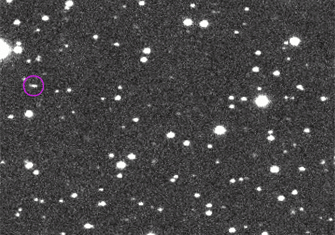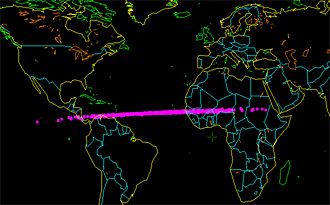This plot shows the range of possible locations where the small asteroid 2014 AA struck Earth's atmosphere early on January 2, 2014.
Bill Gray / Project Pluto

Catalina Sky Survey / NASA
Discovered on New Year’s Eve by a telescope in Arizona, a small asteroid struck Earth somewhere over the Atlantic Ocean — apparently unnoticed — about 25 hours later.
It was New Year’s Eve, but that didn’t stop observer Richard Kowalski from scanning the sky for near-Earth objects (NEOs).
He hadn’t been using the 60-inch telescope on Arizona’s Mount Lemmon for long when he noticed a 19th-magnitude blip skimming through northern Orion in a seven-image series begun at 5:16 p.m. (1:16 Universal Time on January 1st). After confirming that it was a new find, Kowalski dutifully submitted positions and times to the IAU’s Minor Planet Center. Then he went back to the night’s observing run.
Thus did the Mount Lemmon reflector, part of the Catalina Sky Survey, discover 2014 AA, the first asteroid found this year. But at the time neither Kowalski nor anyone else realized that the little intruder was only 300,000 miles (500,000 km) from Earth and closing fast.
To read the rest of this fascinating article from Sky & Telescope, click here …

